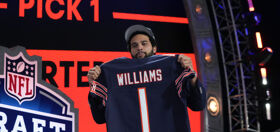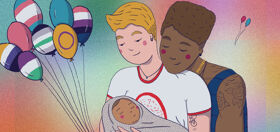
When Narcissus looked in that pond, he saw a work of art. It’s only natural, then, that we take a look at actual works of art. After the jump, Interview Magazine‘s assistant editor, Justin Conner, takes a look at narcissism in art and finds its socialite younger brother: the dandy.
Narcissism is a loaded concept, especially when uncovering gay themes in art. And just as it’s loaded, it’s big. Enormous, in fact.
The great, gay Italian Renaissance masters like Michelangelo and Donatello’s love of men and boys was cultivated in their work–especially in their studies of David (pictured below). Both men’s interpretations are prime examples of homoerotic desire and fetishism of physical sexual prowess.
Michelangelo’s David has thick neck, cut arms, and bulging thighs that provide a perfect contrast to Raphael’s boy with long curls, smooth midsection, and a pubescent build. While they stand at opposite ends of an ideal, both elicit desire and even jealousy through their effortless look of perfection and seductive mask of self-love. With cocky poses like those, who wouldn’t want to look?


The rise of Dandyism during the late 18th and 19th century took the ideal out of the Roman baths and into the salons. Largely credited to Beau Brummel, the movement solicited desire and disdain not from physical prowess, but from that maybe old-fashioned idea of personality. Exercising charm, wit, and elaborate dress, the later dandy set up a new diagram of the masculine ideal drawn from the literary traditions of Oscar Wilde’s witticisms and interpreted as the cultivation of the personage by F. Scott Fitzgerald. A student in self-cultivation, not to mention totally self-absorbed, the dandy attracted those who wanted to brush up against some of the glamour he exuded–or at least learn what made him tick. He was intriguing, but why the pretense and the show?
How about we take this to the next level?
Our newsletter is like a refreshing cocktail (or mocktail) of LGBTQ+ entertainment and pop culture, served up with a side of eye-candy.
One contemporary artist, 28 year-old Hernan Bas, picks the dandy brain to create some haunting, delicate-looking work that reveals insecurity underneath the seemingly intimidating and impenetrable facade. Bas’s stylized paintings are steeped in literacy fantasy and romanticism, similar to the Pre-Raphaelites, only more overtly gay. His doe-eyed, nubile adolescent boys dressed in animal hides or lounging around in wooded hamlets have a self-conscious air like they are afraid of being discovered acting on a cultural taboo.


Though still idolizing and emoting an air of superiority, Bas’s lyrical interpretations show narcissism as a defensive weapon used for self-preservation. Dandyism picked up the narcissist weapon when a cookie-cutter build wasn’t enough to command respect, or at least to keep from falling into scorned obscurity.
Unfortunately, it seems like gay culture has gone back to the body as the main line of defense where the powers of the mind prove a feeble weapon compared to how many hours are spent at the gym or time taken to be waxed.
-Justin Conner-
Related Links:
Galleries and museums where you can find Michelangelo [Artcyclopedia]
Where you can see some Donatello [Artcyclopedia]
They take Dandyism very seriously [Dandyism.net]
Pre-Raphaelites
Oscar Wilde Lovers [The Official Website of Oscar Wilde]
Read Fitzgerald. You’ll love him. [University of South Carolina]
See more Hernan Bas [Saatchi-Gallery]
Even more Bas [the-artists.org]
Images (Top to Bottom):
Hernan Bas, “Tail Coat,” 2006 acrylic, gouache, and water-based oil on linen
Michelangelo, “David”
Donatello, “David”
Hernan Bas, “Red Herring” 2004, oil on canvas
Hernan Bas, “Burning Up for Your Love” 2005, Mixed media on paper




















